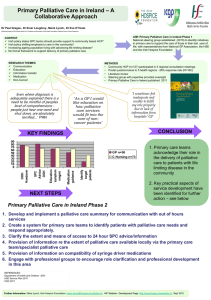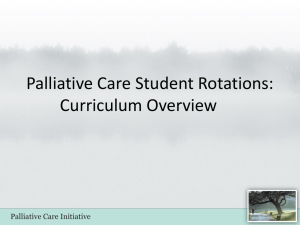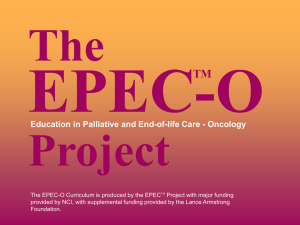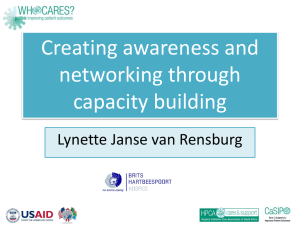Staff training package (PPT presentation)
advertisement
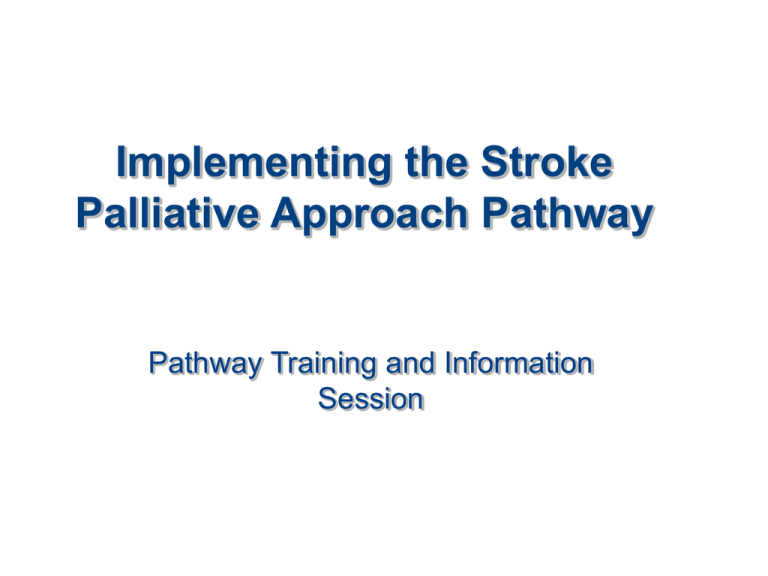
Implementing the Stroke Palliative Approach Pathway Pathway Training and Information Session Aim • To provide staff caring for palliative stroke patients with the knowledge and skills to implement the Stroke Palliative Approach Pathway (SPAP), including discharge criteria Session Outline • • • • Review the principles of palliative care Care pathways and why we are utilising them How to utilise the SPAP Possibility of discharge home and how this will this be raised with carers / families • Process of discharge • Resources developed to support use of the SPAP Principles of palliative care • • • • • Provides relief from pain and other distressing symptoms Affirms life and regards death as a normal process Intends to neither hasten nor postpone death Integrates the psychological and spiritual aspects of patient care Offers a support system to help patients live as actively as possible until death • Offers a support system to help the family cope during the patient’s illness and in their own bereavement • Uses a team approach to address the needs of patients and their families, including bereavement counselling, if indicated • Will enhance quality of life, and may also positively influence the course of illness World Health Organisation (2009) WHO Definition of Palliative Care Geneva Palliative Stroke Care • WHY – Growing interest in the role of palliative care in non-malignant disease, including stroke – Despite the high mortality and morbidity level in stroke, evidence to guide palliative care in this area is lacking – Limited information available on the needs of carers, especially in regard to possibility of discharge home Palliative Stroke Care Why develop a pathway? • Supports National Stroke Foundation recommendations (1.12) Clinical Guidelines for Acute Stroke Management National Stroke Foundation 2007 Palliative Stroke Care • Supports recommendation nine of the Stroke Care Strategy for Victoria – Appropriate and culturally sensitive palliative care should be provided and communication with carers / family members undertaken in accordance with existing national guidelines and Strengthening palliative care – policy for health and community care providers 2004-09 Care Pathways Care Pathways • Map out a patient’s journey – ‘the right people, doing the right things, in the right order, at the right time, in the right place, with the right outcome’ Care Pathways • Main aims of utilisation: – Help improve clinical outcomes – Support the introduction of evidence-based medicine and use of clinical guidelines – Improve multidisciplinary communication and care planning – Decrease unwanted practice variations – Improve clinician – patient / family communication and patient satisfaction – Help ensure quality of care and provide a means of continuous quality improvement Care Pathways • Benefits: – Reduce variations in care from case to case (and consultant to consultant) in the same department – Facilitate the introduction of local protocols based on research evidence into clinical practice – Encourage multidisciplinary communication and care planning – Enable new staff to learn quickly the key interventions for specific conditions and to appreciate likely variations – Embed clinical audit into daily practice Development of Stroke Palliative Approach Pathway (SPAP) • Based on the Liverpool Care Pathway (LCP) and adapted for local use • Goal of pathway: – Meet the needs of patients and their carers by providing timely assessment, education and access to palliative care services as required Stroke Palliative Approach Pathway (SPAP) • Introduction – Sets out the objective, criteria and use of the pathway • Section 1 – Initial assessment and initiation of the palliative approach • Section 2 – Ongoing care and assessment • Section 3 – Discharge home • Section 4 – Verification of death Utilisation of the SPAP • When to commence the pathway • How to utilise the pathway • Who completes each sections Resources developed • Carer brochures – Palliative care after stroke – Information for families and carers – Providing end of life care at home for your family member – Information for families and carers – What to do when someone dies – Information for families, friends and carers Resources developed • Where they will be kept • Who will give resources out Discharge Home Why examine the process of discharge for palliative stroke patients? • Population which has not been greatly examined from a discharge process perspective •To facilitate a smooth and efficient discharge for palliative stroke patients whose families would like to take their relative home to die •To guide staff in the process of discharging palliative stroke patients home (via the pathway) The aim is not to persuade or ask families to care for their family member at home but rather attempt to fulfil the families wishes should they want to take their relative home Resources to Support the Discharge of Palliative Stroke Patients • ‘Providing end of life care at home for your family member – Information for families and carers’ brochure • Stroke Palliative Approach Pathway - Section 3 Considerations for the discharge of a palliative stroke patient • The exact process will vary for each individual patient • A discussion must occur between appropriate senior staff and the patient’s family / carer to determine proposed location of dying (and documented in Section 1a of the pathway) • If the proposed location of dying is at home, this can only be confirmed following all relevant Allied Health assessments (i.e. OT assessment of home environment) • Potential differences to a ‘standard’ acute discharge home - High carer needs (i.e. training, support) - Family emotion / grief - Short time frame to organise discharge - Anticipate only short period (i.e. days) at home prior to death Conclusion • The SPAP should be utilised for all palliative stroke patients after documentation in the medical record and discussion with the family • Resources should be provided to family / carers as needed
